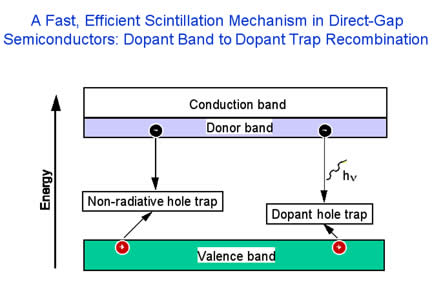Fast Scintillation Detectors Using Direct-Gap Semiconductors
APPLICATION OF TECHNOLOGY:- Detection of ionizing radiation (e.g. x-rays, gamma rays, neutrons)
- Nuclear materials detection - Nondestructive materials evaluation - Nuclear medical imaging - Electromagnetic shower counters for high energy physics and astrophysics - Oil well logging
ADVANTAGES:
- Doping strategy is designed to transform a direct-gap semiconductor into a fast, luminous scintillator - The CdS(In, Te) scintillator has good luminosity and a response time of 3 ns, 10 to 100 times faster than conventional scintillators - Improved doping of CdS scintillator will further increase both luminosity and speed
ABSTRACT:
Stephen Derenzo, Edith Bourret-Courchesne, Mattias Klintenberg, and Marvin Weber are developing a new class of room-temperature semiconductor scintillators with an extraordinary combination of efficiency, speed, and energy resolution for the detection of x-rays, gamma rays, and neutrons. This is the first time that a semiconductor has been intentionally doped with two impurity atoms to convert ionization energy into fast scintillation light with good efficiency.
The Berkeley Lab direct-gap semiconducting scintillators are based on a previously unexploited scintillation mechanism where electrons in an impurity n-type donor band recombine with ionization holes trapped on impurity acceptor ions. These scintillators can be highly effective in detecting and identifying radioactive materials, and their timing resolution will aid in the detection of other hazardous materials by time-of-flight neutron activation.
Research:
Derenzo and colleagues have successfully codoped cadmium sulfide with indium to make the material n-type, and with tellurium to trap holes. The indium doping provides energetic electrons throughout the material and the tellurium doping traps the holes produced by ionizing radiation before they can be lost to non-radiative traps. This novel combination of dopants results in a scintillator with the same red emission as the slow tellurium-doped scintillator but with a fast decay time of 3 ns. Further work is underway to substantially increase the luminous efficiency by replacing the tellurium isoelectronic hole trap with an impurity acceptor ion.
Attached files:

Patents:
US 7,048,872
Inventor(s): Stephen Derenzo, Edith Bourret-Courchesne, Mattias Klintenberg, and Marvin Weber
Type of Offer: Licensing
« More Biotech Patents
